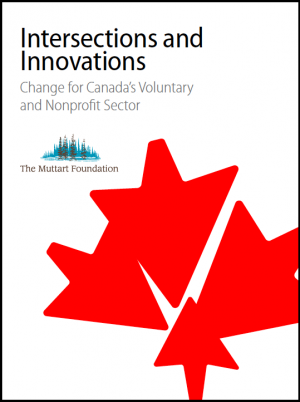Excerpt from the book “Intersections and Innovations: Change for Canada’s Voluntary and Nonprofit Sector,” which is edited by Susan Phillips and Bob Wyatt and published as a free e-book by the Muttart Foundation.
Chapter 10: Giving and Fundraising Trends
By Sharilyn Hale
Traditionally, “giving” in Canada has been understood as making a tax-receiptable donation to a registered charity for an intended purpose. Increasingly, a wider view of what “giving” and being “philanthropic” are has been evident with the embrace of additional ways to make a difference and advance social development and impact. From crowdfunding (to which contributions are usually not tax-receiptable and which often go directly to individuals rather than charities), to market vehicles such as impact investing and social finance, entrepreneurial incubation, and even remittances by diaspora communities – all are often categorized together as “doing good.” Even cause-related marketing, corporate social responsibility (CSR), and environmental sustainability and governance (ESG) programs have grown as corporate charitable programs have diminished, broadening the understanding of corporate social commitments from simply making charitable donations. In all these cases, the focus is on a goal, and not the vehicle to achieve it.
 On one hand, a diverse range of strategies and vehicles for people and companies to do good is important and heartening and recognizes that intractable issues need to be tackled from multiple directions. On the other hand, this shift raises a host of concerns about the future for charities, which rely on more traditional forms of giving. At a time when we have seen a decline in the overall number of philanthropic donors, we must ask whether these alternate ways of giving are supplanting traditional philanthropic giving.
On one hand, a diverse range of strategies and vehicles for people and companies to do good is important and heartening and recognizes that intractable issues need to be tackled from multiple directions. On the other hand, this shift raises a host of concerns about the future for charities, which rely on more traditional forms of giving. At a time when we have seen a decline in the overall number of philanthropic donors, we must ask whether these alternate ways of giving are supplanting traditional philanthropic giving.
For instance, there is a sizable body of research indicating that “giving” by purchasing a product (coined “consumptive philanthropy”), for example, negatively impacts the likelihood of future donations to a charity (Eikenberry, 2009). The backbone of social capacity, charities in Canada need strong infrastructure and community support to deliver on their social mandates. Bridging the divide between traditional philanthropy and new forms of doing good will be a key challenge for the charitable sector in the years ahead.
Click here for access to a pdf of Chapter 10, “Giving and Fundraising Trends” (including sources), by Sharilyn Hale, as well as access to other chapters.
Sharilyn Hale is a member of the Advisory Council for the MPNL program and President of Watermark Philanthropic Counsel. Drawing on expertise in philanthropic strategy, family engagement, organizational development, and governance, Hale enables philanthropists and their families to unearth and achieve their philanthropic goals, and helps social-purpose organizations deepen their performance. Join Sharilyn Hale on Twitter or LinkedIn.
Friday, September 10, 2021 in Intersections & Innovations
Share: Twitter, Facebook



